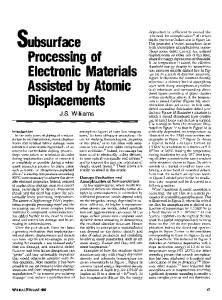Plasma and Ion-Beam Assisted Materials Processing
- PDF / 35,514 Bytes
- 2 Pages / 584.957 x 782.986 pts Page_size
- 79 Downloads / 330 Views
André Anders Lawrence Berkeley National Laboratory, Berkeley, California 94720
Joakim Andersson Centre for Quantum Technologies, National University of Singapore, Singapore 117543, Singapore
David Horwat Institut Jean Lamour, Université de Lorraine, Ecole des Mines, CS14234 Parc de Saurupt, Nancy 54042, France
Mykola Vinnichenko Helmholtz-Zentrum Dresden-Rossendorf (HZDR), Dresden 01314, Germany
Plasma and ion-beam surface treatments by energetic particle bombardment enable a high degree of freedom and control of surface material chemistry and microstructure. The development of plasma and ion-beam surface modification methods and tools has allowed the synthesis, modification and exploration of new technologically important materials. Plasma surface treatments together with low energy (, 5 keV) ion-beam processing of surfaces, thin films, and nanostructures result in new phases and metastable states that directly impact the chemical, physical, and morphological properties of the material. Thus, this field is highly relevant for new applications such as tribological, optical and biomedical coated surfaces. Depending on the particle energy and type (neutrals, positive or negative ions), energetic particle bombardment can determine thin film structure and properties by: d condensing metastable phases, forming strong material bonds, and creating smooth surfaces d limiting mechanical stress that often leads to delamination of the layers d growing generally dense films at reduced deposition temperature with the ability to tune film porosity, optical, electronic, and mechanical properties. For example, one can affect the refractive index and mechanical stress in the case of the optical coatings, and the free electron mobility in the case of the transparent conductive oxides (TCO), influenced by the formation of defects which may trap and scatter free electrons. The variety of thin film deposition methods utilizes plasma assistance to achieve a desired combination of functionalities. The most established techniques include magnetron sputtering (MS), plasma enhanced chemical vapor deposition (PECVD), pulsed laser deposition (PLD), and filtered or unfiltered cathodic vacuum arc deposition (CVAD). The flexibility of many of those processes may be further increased by applying pulsing.
DOI: 10.1557/jmr.2012.53 J. Mater. Res., Vol. 27, No. 5, Mar 14, 2012
To analyze film deposition involving energetic particles one has to consider both particle fluxes to and from the substrate. Particle-induced desorption as well as physical and chemical sputtering during growth can have a great influence on the film growth rate, microstructure, and texture formation. Since many of the arriving particles are ions, the substrate is highly biased (e.g. hundreds of volts) which can increase the sputter yield to a point where ion etching dominates over film deposition. However, ion etching can be utilized for surface pretreatment prior to film deposition. In the last decades, thin film technologies have evolved significantly, supported by novel models describing
Data Loading...











